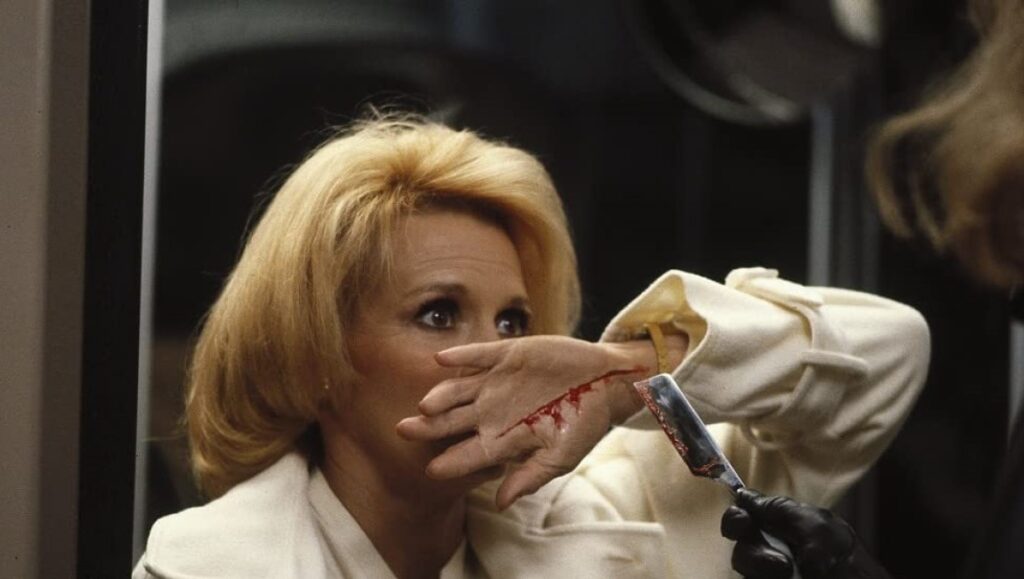Brian De Palma is the great voyeur, the plump-bellied pervert of post-Hitchcock American cinema. His films have a singularly sleazy feel, gloriously gaudy and admirable in their ribald ridiculousness. There’s a thrill, a sense of danger, in the act of looking. Consider the high school girls shot in salacious slow-motion in the beginning of Carrie; or Rebecca Romijn making out with a supermodel in a fancy bathroom stall, like something out of an adolescent boy’s fantasy, in order to steal a gold bikini at Cannes (a festival that has always rejected De Palma) in Femme Fatale; or the sleazoid horror flick-within-the-film at the beginning (and end) of Blow Out, that piteous scream howling in the dark forever; or the sexy girl dancing for an audience of one in Body Double. And, of course, there’s Nancy Allen stripping to turn on Michael Caine’s psycho psychiatrist in Dressed to Kill, the closest the filmmaker has yet come to making a Giallo (there’s a fun homage to Argento’s Tenebrae at the end of Raising Cain, too). Dressed to Kill has the gleam and gore of an exploded id, a world of sordid secrets and dirty streets rife with sad, angry souls and shiny metal glinting like the last dying flicker of a woman’s tear-glazed eye.
The film opens with softcore groping in a shower as whorls of steam caress Angie Dickinson’s body double (Victoria Johnson, who had previously posed for Penthouse) as lasciviously as her own enraptured hands, doing slow, porny curlicues as soap cascades down her wet thighs like happy secretions. Then, a surreal twist of violence, a man taking her brutally from behind, which leads to a sudden snap back to the sad reality of a limp, wham-bang quickie with a man who hasn’t stirred her passions in a long time. Dickinson’s unhappy housewife, Kate, goes to her shrink, Dr. Elliott (Michael Caine, who is very good, indolent, and understanding at first, then uncharacteristically creepy in the end, and for his work was rewarded with a nomination for a Golden Raspberry), and bemoans the banality in which she is so painfully mired. Seeking some solace, she goes to the museum, where a mysterious man catches her gaze, and in a scene of lovely oneiria, she follows him, another one of De Palma’s voyeurs, the camera gliding with sensuous fluidity through rooms of beautiful art with naughty intentions.
Kate finally has a satisfying carnal experience, only to quickly find out that the lover in question has an STD. Then, as further punishment for her indiscretion, she runs into an odd-looking woman with sunglasses, great black voids where her eyes should be, who has been looming in the background like an inevitability you keep denying. She slashes Kate to shreds in the elevator with a razor, that Giallo-red blood spilling everywhere. A classy call girl, Liz (Mrs. De Palma, Nancy Allen), happens to be waiting for the elevator and sees Kate’s bedraggled body lying sloppy on the floor, her hand reaching up weakly, pathetically, eyes already dulling, silently begging for help. Wrong place, wrong time. A very New Yawk cop (the Godly Dennis Franz) yells at Liz, and gives her the choice of helping or spending some time in the slammer, so she teams up with Kate’s son, Peter (Keith Gordon, who had a hell of a run early in his career, e.g., John Carpenter’s Christine, before turning to directing television), to catch the killer. Peter happens to be ingenious with gizmos and gadgets — much like De Palma was as a kid — and Liz proves to be rather resourceful herself.
Dressed to Kill, the rare ‘80s thriller that’s actually erotic, opens with a brilliant, half-hour-long fever/fuck dream that renders both female lust and lustful fantasy, and then disposes with its avatar even more cruelly than Hitch did Marion Crane. De Palma has a fetish for the histrionic; his films are governed not by the rules of reality, with its rigor and staleness, but by the aberrant logic of cinema. Though a semblance of our world may seep in, with all the force of a chilly breeze through a cracked-open window, De Palma’s films are concerned more with opulence than mimesis. By that measure, the elevator set-piece here stands beside anything that Hitchcock ever did, while holding its own in the gore department at the advent of the slasher trend. But this writer is also particularly taken with the scene of Liz riding the squalid subway, gnarly with grime and befouled with the looping scribbles of a paint can-happy kid, one of the good-for-nothings Giuliani scrubbed out. The camera lurks, it pans; that silent stalker, the woman in black, watches from the next car as the train lurches around a curve, the sibilant scree of metal rumbles in the dark. A cop is there; elsewhere, a gaggle of hoodlums waits for Liz. Life in the big city.
Part of Kicking the Canon — The Film Canon.
Published as part of InRO Weekly — Volume 1, Issue 27


Comments are closed.